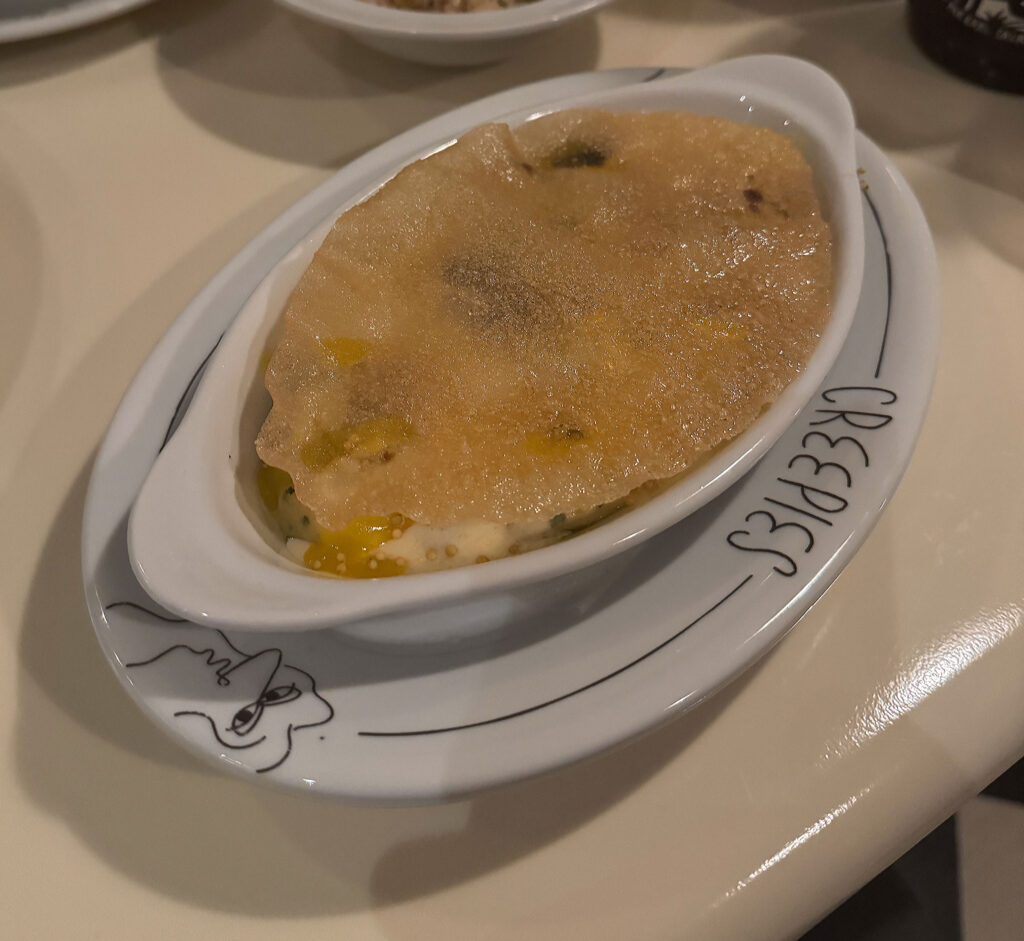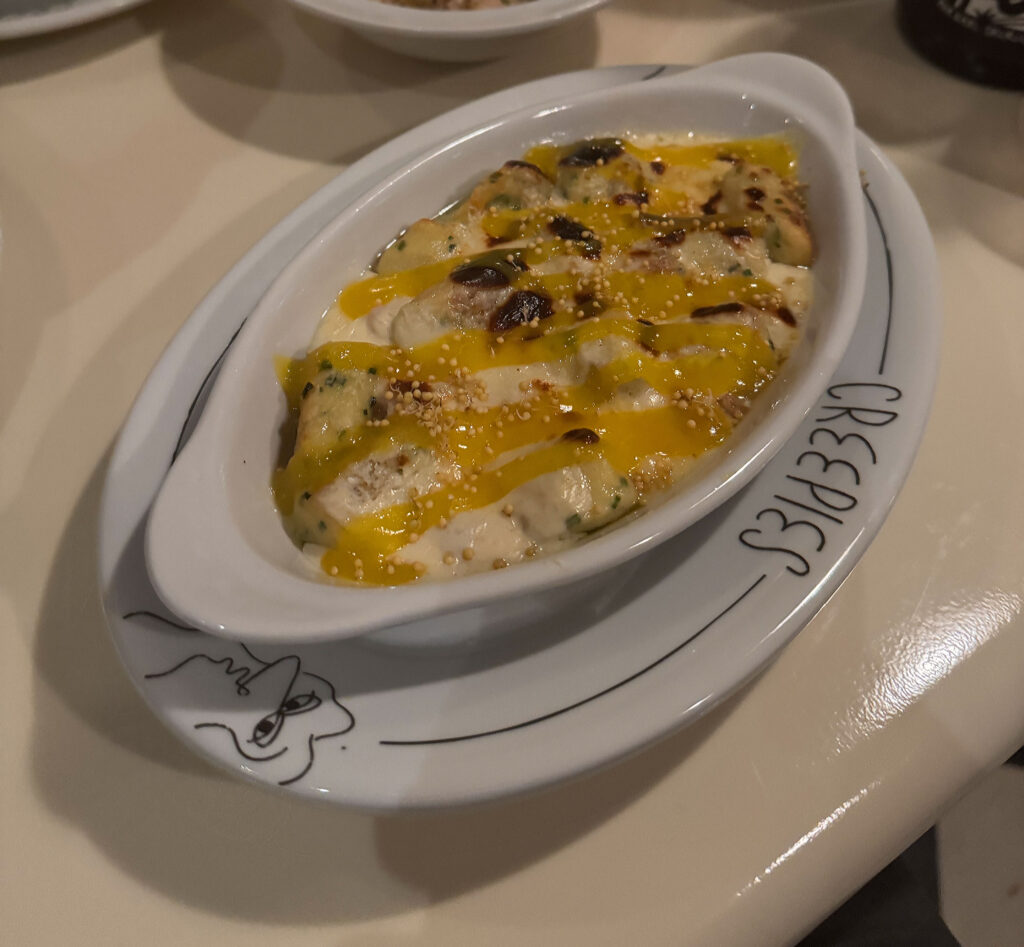This meal represents my sixth visit to Creepies: the characterful new bistro from the Elske team whose 60 or so seats remain in high demand.
I’m probably more sensitive to the restaurant’s growing pains than most patrons—charmed by all the positive press (most notably Michelin’s nod)—walking through the door. After all, they’re just happy to be here, excited to enjoy the novelty of each recipe, and eager to share in an experience—whether it meets expectations or not—that the cognoscenti have already branded essential.
In contrast, I’m all-too-cognizant of the concept’s flaws, and I arrive with a gameplan: to recognize what might be new and to comparatively taste what is old, pinpointing if or when a dish finally achieves its full potential. Part of me detests the tendency to cheerlead a spot just because it’s new rather than holding it to (and helping it reach) the standard that you know it’s capable of. The other part admires just about everyone involved in Creepies, so I’m driven to be constructively critical in a friendly way even as I fight a hype machine that, while beneficial to content creators, actually makes it harder for a kitchen to find its feet.
Still, it’s thrilling just to be at one of those tables that everyone (at least for now) covets—to be surreptitiously situated alongside Chicago’s most discerning (or otherwise trend-chasing) diners and a silent witness to how the team handles this pressure.
To be clear, there’s a lot about Creepies I do already like. Give me one of those mixed drinks or a bottle of natural wine, throw in an order of fries, and I can watch the circus all night. Let me feel the warmth of the servers and see the continued creative effort of the chefs, and I’ll keep coming back just to be the first to declare when everything finally clicks.
The two-month mark forms a decisive milestone in any restaurant’s lifecycle. In short, it’s the point when a concept is thought to be performing at something like its true level. It’s the time when criticism of a definitive, star-rated sort is finally fair game.
I’ve certainly eaten here enough times to now offer some kind of conclusion. However, I do not really feel compelled to do so: to mark Creepies with finality after I’ve already made my misgivings known. Rather, I want to afford the menu more time and more opportunity to explore its chosen domain.
No doubt, there’s something inherently unfair about giving one place more than six chances to impress while pretending you have another all figured out after visiting only thrice.
The best explanation I can give is that some restaurants (the latter) look to succeed conventionally within the boundaries of a recognizable format or cuisine, and one can judge them confidently relative to other examples in the same market. Yet a select few (the former) subvert or reimagine their chosen genres to such a degree—are so firmly committed to a singular voice and philosophy—that I am compelled to patiently support their process even in the face of imperfect execution. Yes, a certain individualism and clear capacity for growth form virtues that are worth fostering.
Ultimately, the food needs to taste good (and would-be customers, at any given moment, should also know what they are really getting into). But I’ve seen the time it has taken for Cellar Door Provisions or Obélix (somewhat kindred concepts) to hit their stride, and Creepies is working within a niche—though nominally a bistro—that actually resists comparison.
The assembled talent has sought to build something that looks, feels, and tastes unique even when viewed from a national perspective. The team is seizing that rare opportunity to succeed in a manner that is wholly their own. Thus, the concept needs to be evaluated with respect for the ways in which it tries to be different. Its food must be given room to please in ways that are not prototypically homey or hedonistic.
This piece—the good and the bad of it—serves as just another snapshot in a process of becoming that could very well end in excellence. Participating thoughtfully in these early stages of development, instead of selfishly asking that the restaurant bend to their proclivities, is really some of the most fun an experienced diner can have.
Let us begin.

At this point in the season, Creepies’s breezy summer aesthetic—those open windows and awnings that seemed to invite the energy of Randolph Street right into the cozy bistro—is long gone.
Patrons are now funneled through a door marked 1360 that they could be forgiven for overlooking back when guests (and would-be guests) seemed to flow around the host stand with ease. The surrounding sidewalks are not empty (of gymgoers, dog walkers, or delivery robots), yet everyone seems to move more briskly. The best-dressed of the bunch, rather than touring the block, step out from Ubers and make beelines for Elske or its scintillating sister property.
When I enter the latter restaurant just a few minutes after opening, the greeting is warm and the mood almost eerily calm. The dining room hums when it’s at maximum capacity. Chairs and bodies must be kindly sidestepped when traversing the space. But only one other party is present, and Creepies—just for this moment—feels like a quaint cabin in some undiscovered quarter. Weirdness (those marks of personality nestled on shelves or in corners) abounds. However, in this relative stillness, the concept evokes some of its intended vision: of the neighborhood place that is at peace with its idiosyncrasy, the comforting haunt that stands ready to please as only it knows how.
Over the next hour and change, each of the tables and seats at the counter will fill. That fashionable, white, middle-aged crowd will take their rightful places and paint the wood paneling with a buzzy sheen. They’re not the only ones here (and, indeed, I’ve been heartened by the diverse clientele on other nights). They’re just the loudest, and one may find themself unwillingly serenaded by the sound of “foodie” dick-measuring.
Other than the jealous looks (given that my table is laden with close to a dozen bottles and plates while theirs, only just occupied, sits empty), I actually enjoy the spectacle. The stakes are high because the expectations are high, and the majority of people coming through the door have strong opinions that they are more than willing to share. After all, you know what’s better than dining at the city’s trendiest spot? Telling anyone who will listen that it actually sucks.
Maybe the hype will never die, and Creepies will remain a darling of the West Loop’s growing occupancy. Maybe it will, and the concept will become something more of a cult favorite: a haven for those who are equally offbeat and more than willing to indulge the team’s stranger compulsions.
The answer may have something to do with the degree the team compromises on their vision—not just through small conceits like roast chicken and fries but with cocktails, wine, and a wider culinary program that speaks to mainstream tastes. Who wouldn’t want to see onion soup, duck confit, steak frites, or soufflé (washed down with a French 75 or glass of Beaujolais) interpreted by such talented chefs? On the other hand, why even bother entering this genre if you’re just going to regurgitate the hits?
If Elske’s work is anything to go by, I don’t think they’ll blink.
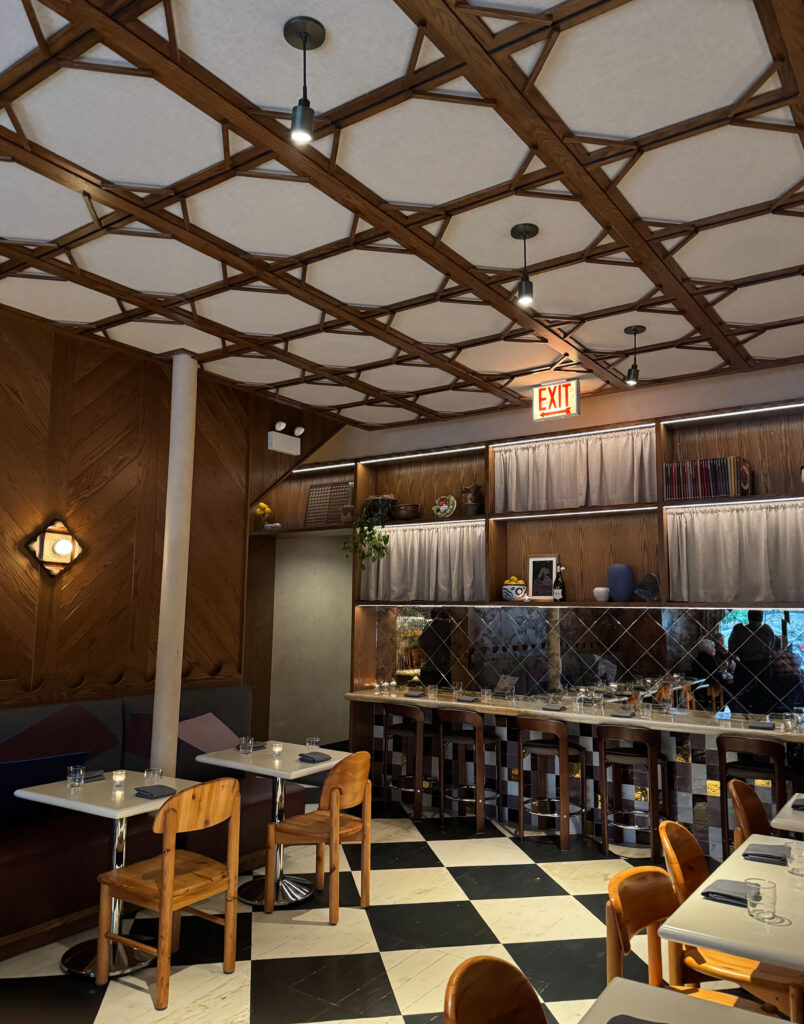
Having now reached the table, I make the acquaintance of my server.
In the calm of this early evening atmosphere, their greeting is refreshingly casual. However, they go about their duties with all the precision I expect from this group, and they marry it with an inquisitive nature that makes for easy conversation throughout the length of my experience.
I am most impressed by the manner in which the server highlights and painstakingly describes dishes that have been added to the menu since my last meal. Once I sample these recipes, the genuine solicitation of feedback affirms just how conscientiously (and with what humility) the team treats their work despite every indication (if a full dining room is anything to go by) of success.
I should also praise how graciously the staff handled a phone that was left behind by one member of my party: notifying the host within minutes of their departure and even offering to send the item via courier if it would be more convenient than returning to grab it.
While I’ve read about long waits (despite reservations) and occasional inattentiveness (when refilling water for example) when Creepies hits max capacity, I’ve never encountered either firsthand. This is not to say it doesn’t happen. Rather, across a wide array of visits and a rotating selection of servers, the attitude underlying the practice of hospitality at this restaurant has always rung true. The Elske DNA is clearly there, and issues of timing or mechanics are no match for a wider bonhomie that will always put guests’ needs first (even if it might take more time to achieve total consistency).
Otherwise, before moving on to the food, I must yet again sing the praises of the beverage program here.

On the “Mixed Drink” side, I sample a new “House Sazerac” ($16) from Monica Casillas-Rios that ranks among the bar manager’s very best work. The blend of Cognac, rye, Demerara sugar, bitters, and Chartreuse Elixir Végétal is served in a thoroughly frozen tumbler, which serves to soften the punch of the chosen spirits. That being said, they’re by no means buried. Rather, their sharpness is beautifully integrated into a smooth, sweet package that not only concentrates everything one loves about the cocktail yet somehow improves upon it. Yes, I may be partial to Chartreuse, but substituting Herbsaint with the monks’ Herbal Elixir strikes me as genius. Overall, this is an incredible effort that ranks among my favorite tipples of the year.
On the wine side, Emily Sher continues to steward the selection in a manner that remains true to concept’s renegade ethos without totally punishing those whose palates leans more toward convention. I’m happy to see cult names like Jean-Yves Péron (with a sparkling pear cider no less) and Mazière (with a wonderfully elegant expression of Grenache) enter the fray. However, it’s through the inclusion of a Loire Sauvignon Blanc (Clos du Tue-Boeuf, $15) and a Merlot-dominant Bordeaux (Château Le Puy, $20) by the glass that everyone can feel welcome—learning about a side of “natural wine” that is expressive without being polarizing.
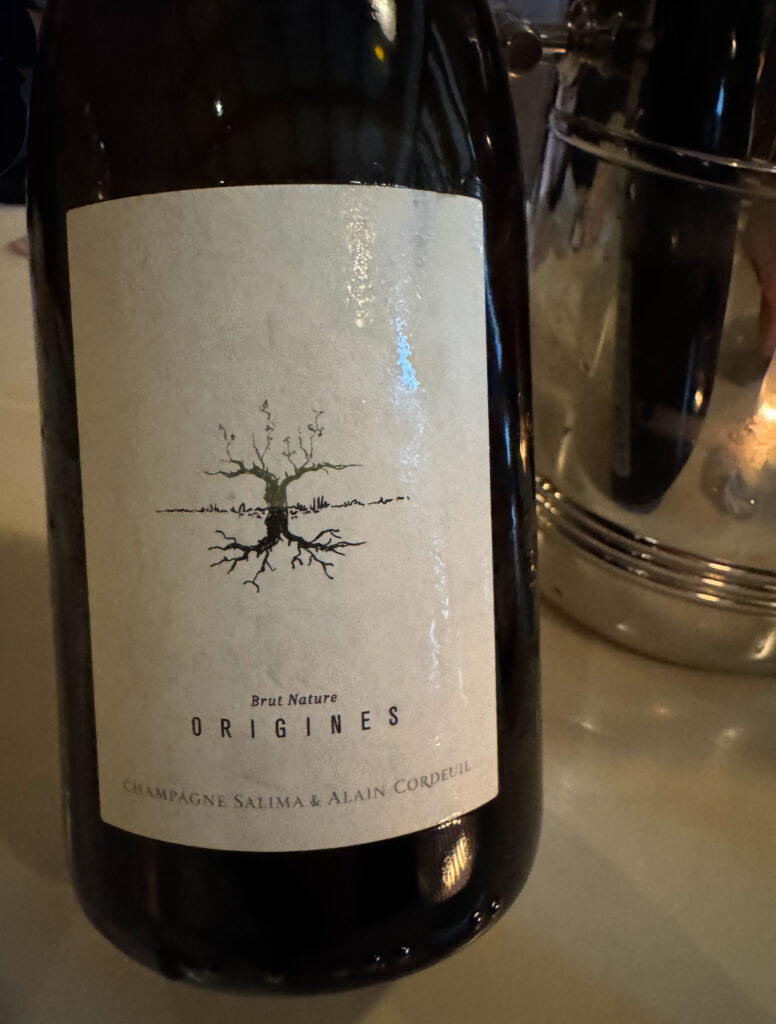
Toward the high end, I am happy to sample an organic, brut nature Champagne from Salima et Alain Cordeuil (“Origines,” $235). It’s not a producer I’ve seen enter this market yet, and the blend of 65% Chardonnay/35% Pinot Noir (benefitting extended lees contact) drinks generously despite the lack of dosage. While the bottle is nearly twice the price of the other Champagne offered, it represents a premium option that parties touting any sort of tastes can celebrate it.
As always, Sher’s work is inspiring due to just how frequently the chosen bottles rotate (a labor of love on both the sourcing and printing side that prevents choice paralysis while maybe even demanding that customers take a leap of faith). If one expresses a kindred passion for natural producers, a pour of something interesting may make its way to the table. If one brings the right bottles as corkage, the wine director may even offer the chance to add on a couple harmonizing vintages that are being held off the list.

All of this adds up to a beverage program of sneaky quality and excitement for those who understand its limitations (self-imposed or not) and speak the same language. All told, a popular audience may be left wanting more, but maybe it’s right that they go seek it from the great number of establishments safeguarding convention? Such places may seem equally stifling to someone who has been initiated into Creepies’s way of thinking, so maybe it’s time to acknowledge that stubborn drinkers on either side should simply go their own ways?
One can never say the choices presented here have not been thoughtfully arranged.
Turning now to the menu, I choose to order 19 of the 23 dishes offered tonight. More particularly, I only choose to excise two of the entrées (“Roasted Chicken,” “Roasted Lamb”) and two of the desserts (“Butterscotch Custard,” “Baguette Soft Serve”) I covered in my last piece.
This allows me to focus intently on those recipes that are new while also comprehensively reevaluating the smaller plates (several of them signature items) that the majority of customers will end up trying. For the sake of convenience, I will place dishes in the order listed on the menu rather than the order in which they arrived (which, in truth, only diverges a bit).
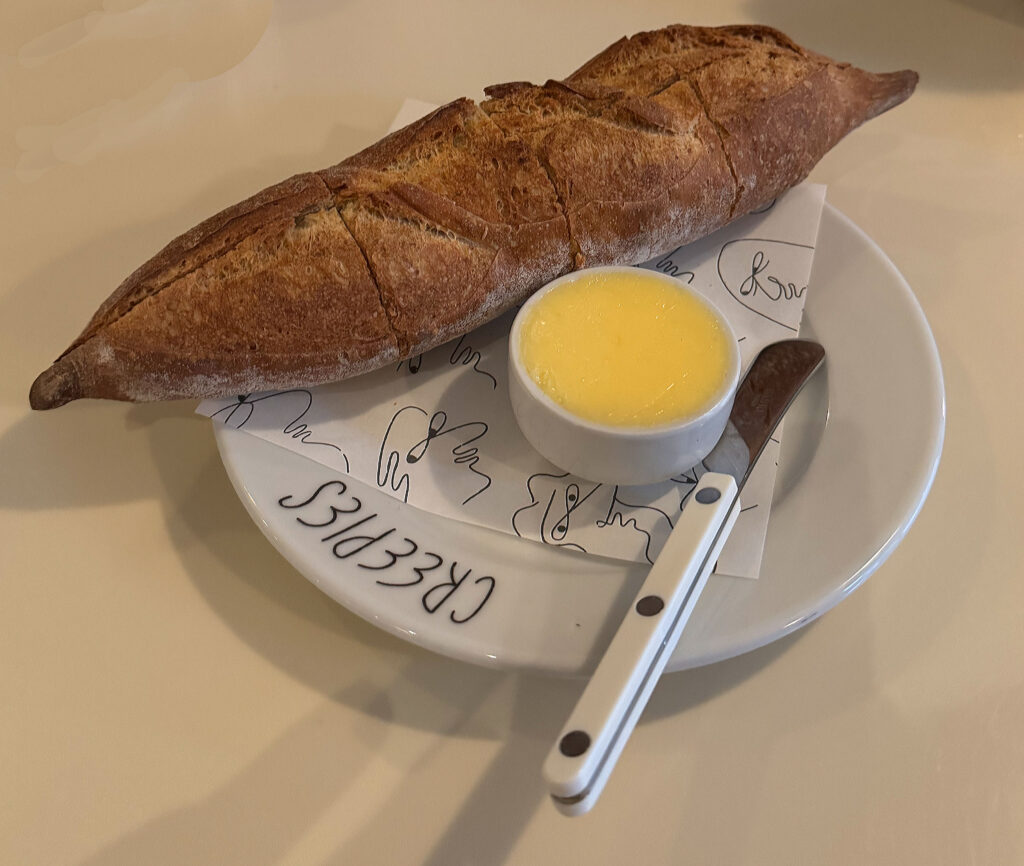
The evening kicks off with a serving of “PQB Bread & Butter” ($8) that has replaced what was once simply titled “Bread & Butter.” The difference here is obvious: rather than baking the baguettes in-house, the kitchen now sources them from Publican Quality Bread (a nod to the restaurant group where the chefs jointly worked and a move that fits the precedent set by the long-running “Publican Quality Oat Porridge Sourdough” over at Elske).
Certainly, I’d love to see this bread made from scratch, but the results were uneven. I also imagine the labor involved (on top of all the gougères, tartes, meringues, and puff pastry also being produced) eventually became disqualifying. Thankfully, with the help of Greg Wade, the baguette satisfies every expectation. It arrives warm, displays an unerring crispness (throughout the entire loaf), and possesses a crumb that is fluffy, perfectly salted, and charged with an earthy, rustic flavor. Paired with Creepies’s rich, beautifully tempered butter, this bread has finally become a standby.
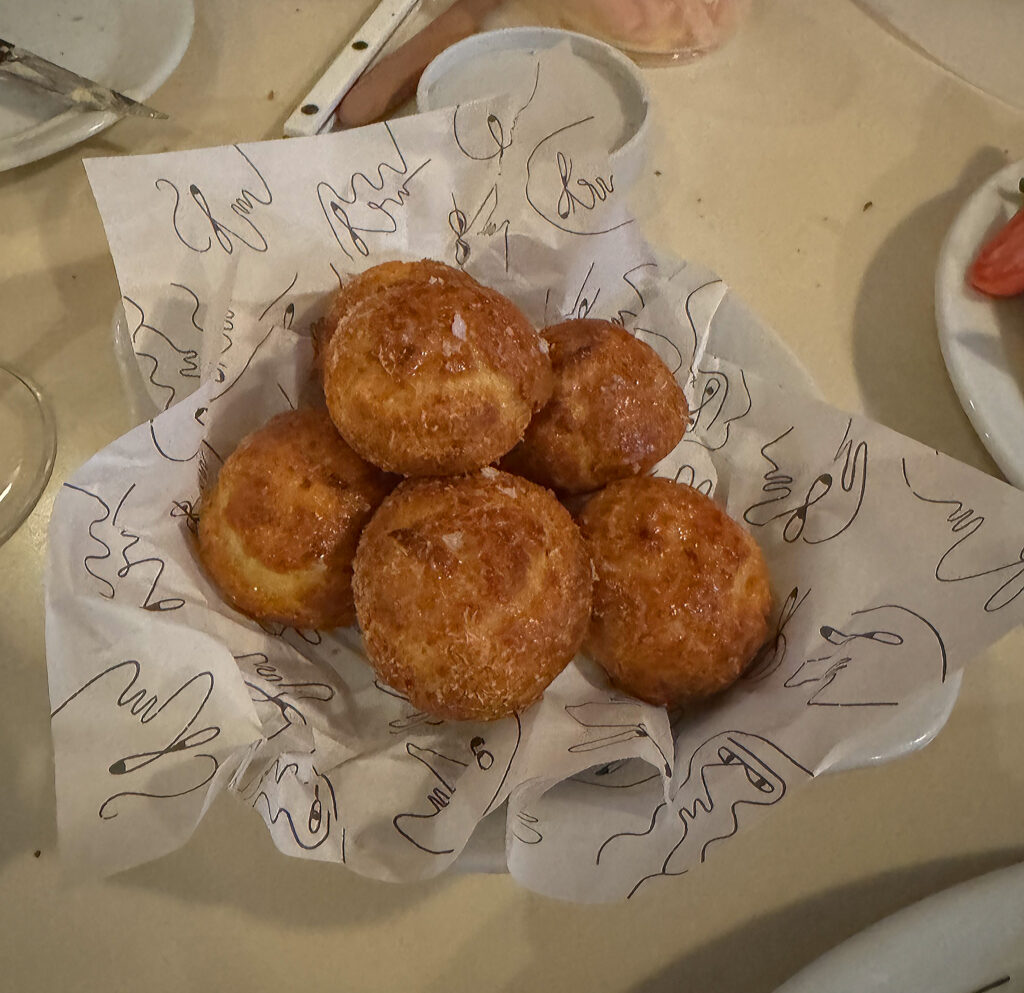
The ”Warm Brie Gougères” ($14) might be the standout of the menu. I’ve definitely ordered it every time I’ve dined at the restaurant. However, I have also pinpointed a lapse in quality from my first encounter (on opening night) through all subsequent versions of the recipe.
Tonight, the balls of choux pastry certainly look the part—being dark and even in their browning while further benefitting from a brush of honey and a sprinkle of flaky salt. On the palate, the gougères feel warmer than usual (a good start) and strike with a subtle crispness that frames their gooey interior of cheese. The brie benefits from the hotter temperature (which moderates its perceived richness), and I like the fact that the accompanying sweet notes (from the honey) have been dialed down too. The result tastes full, earthy, and savory in a way that actually speaks to the starring ingredient’s complexity. Yes, the length of the finish is actually immense, I feel like this dish has suddenly gone from frivolous and almost sickly to totally sophisticated. It represents a clear improvement that just about matches (in terms of quality if not style) what I remember from opening night.
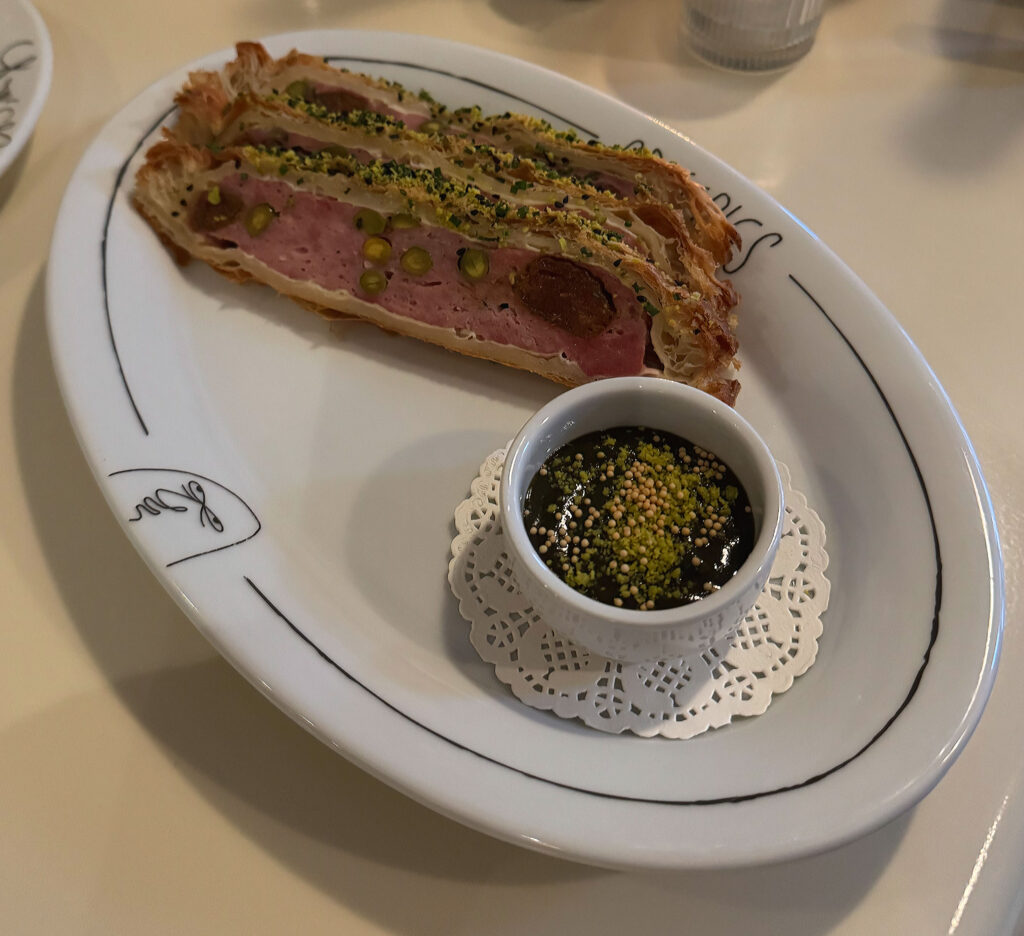
The ”Saucisson with Puffy Pastry & Pistachio Mustard” ($14) approaches the gougères in popularity but has suffered from the same fate: it was executed faithfully early on in the concept’s life but has become limper (and a little disappointing) ever since.
To the recipe’s credit, the sausage itself—which is made in-house and comes studded with nuts—remains superlative. It offers plumpness and moistness and a bewitching porky depth that could carry just about any preparation. Paired with the tangy, sweetly nutty condiment, it absolutely sings. However, that layer of puff pastry remains soft and loose and it totally comes apart should one attempt to cut through it. This element, which should crunchily crown the saucisson, still feels more like a sad, tattered wrapper. Its presence does not totally spoil the dish, yet it does leave me craving the higher pleasure I know it is capable of achieving.
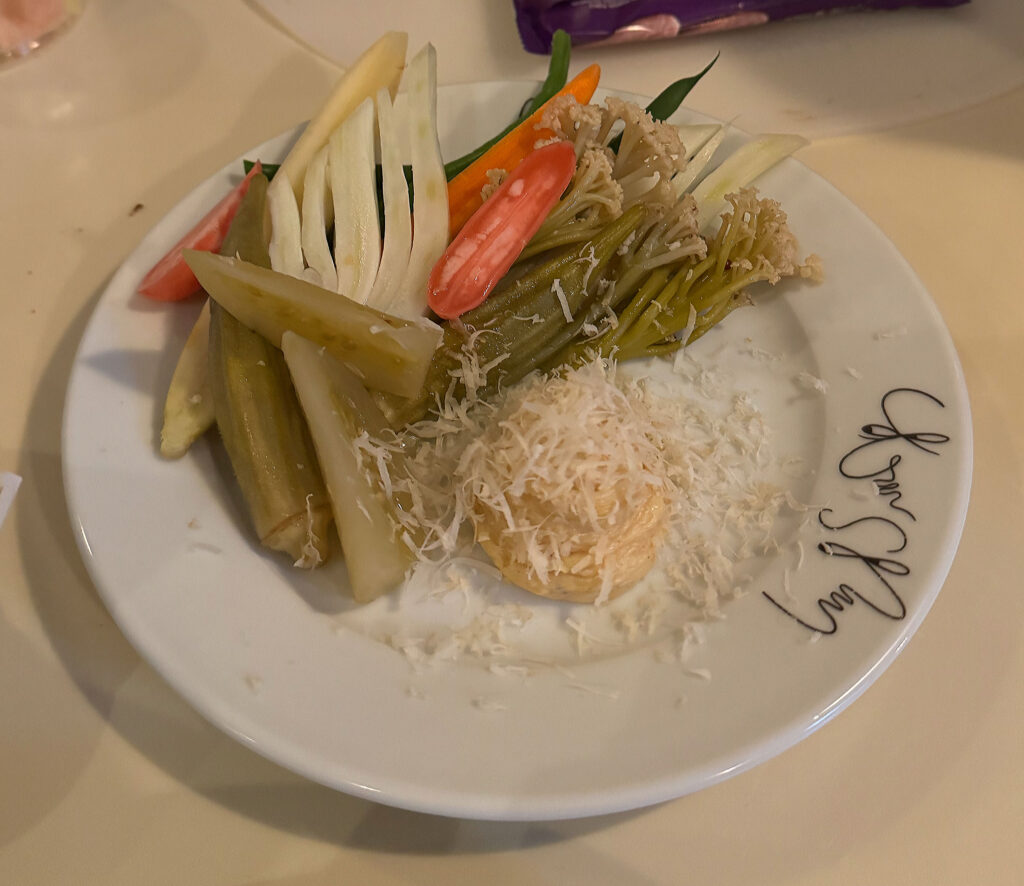
The ”Crudités with Horseradish & Brown Butter” ($10) can be thought of as the ugly duckling among the starters. The other three just aim so squarely at enjoyment while this one represents little more than a plate full of vegetables. That said, many of the chosen ingredients are treated with care, and I have to admit this item (which few of the other guests at my table even touch) is growing on me.
On this occasion, the spread includes baby cauliflower, carrots, green beans, green tomatoes, fennel, okra, and radish that have alternatingly been lightly pickled (the majority) or served raw. The former category excites me the most, for the combination of clean crunch and well-judged sourness serves to invigorate the palate at this early stage. The raw bites (of carrot or green bean) are less exciting due to the fact that the brown butter is practically frozen (that is, a totally inversion of the excellent tempered butter served with the baguette). Likewise, though the amount of horseradish provided has grown, I still do not find any of the pungency I expect from it. Rather, the root offers only a trace of sweetness (which is nice) but not enough power to invigorate some of the blander components of the plate. As it stands, the dish could clearly benefit from more refinement. Any appeal, at present, only comes from the pickles.

Brand new tonight, the “Sunchoke Croquettes with Preserved Lemon” ($14) enters into a long line of fried delights served at Creepies. Yet, somehow, they manage to feel different: looking a bit like mozzarella sticks but coating the titular tuber (also known as Jerusalem artichoke) with a flaky breading, some streaks of lemon aioli, and a thicket of fried rosemary leaves.
On the palate, the croquettes display a remarkable crispness (echoed by the brittle bits of herb) that transitions toward a crumblier sensation with further mastication. The interior segment of sunchoke ultimately proves quite tender, and its latent nuttiness strikes me (keeping the texture in mind) as something like a superior version of a French fry. Now, to be fair, I don’t think this dish quite reaches the superlative quality of Creepies’s actual fries. Nonetheless, by balancing an attractive mouthfeel with layers of earth, salt, and alleviating citrus, the recipe raises a somewhat obscure ingredient to the level of total deliciousness. Well done!
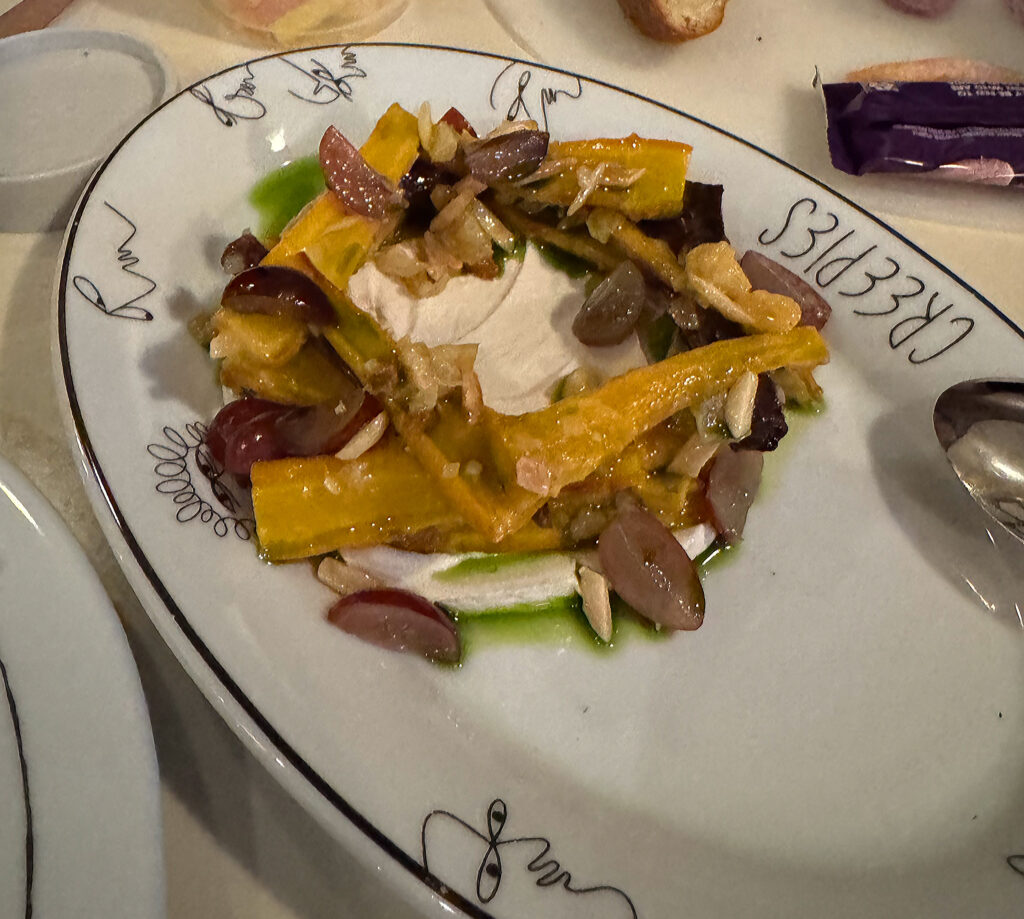
A preparation of ”Roasted Carrots with Almonds, Sultanas & Fig Leaf” ($18) is also new to me, and, if my experiences at Elske are anything to go by, seeing fresh produce take a starring role is always a good sign. These are kitchens that almost dare you to discount what vegetables can express relative to all the meat, seafood, and cheese on offer. Other than an anchoring smear of labneh, it seems like all the dish’s secrets have been laid bare.
However, the trick is really in how convincingly the constituents come together. Namely, the carrots themselves (crisp on entry yet still moist through their interior) meld well with the plumpness of the grapes and the rather mild crunch of the almonds. Meanwhile, the labneh, thick and creamy, helps to fill in the gaps. It richly coats the tongue with a baseline of sourness that allows the brighter sweetness of the sultanas (accentuated by the tropical tones of fig leaf) and the deeper, roasted sweetness of the root vegetable (bolstered by the nutty notes) to really shine. The result feels carefully woven together and absolutely energizing. It delivers just the kind of cleansing, sneakily satisfying sensation I desire at this early stage in the meal.

The ”Little Gem with Parsley Root, Apple & Sunflower Seeds” ($14) is the sort recipe I’d expect to mirror the same effect. I didn’t really love its predecessor (which swapped the parsley root and apple for zucchini), but this is Creepies’s closest thing to a salad—and Elske has demonstrated such a mastery of the form.
The present version offers a nice enough mélange of soft lettuces, crisp apple slices, and crunchier bits of seed and root. With regard to flavor, the slight sweetness of the fruit is a welcome addition. Nonetheless, the salad strikes my palate as rather bland and underdressed. I think its subtlety is meant to be intentional and a bit subversive, yet it almost seems to abandon everything that’s texturally engaging and bracing about such a construction. I hope, at some point, I am able to understand what the kitchen is going for with this composition.
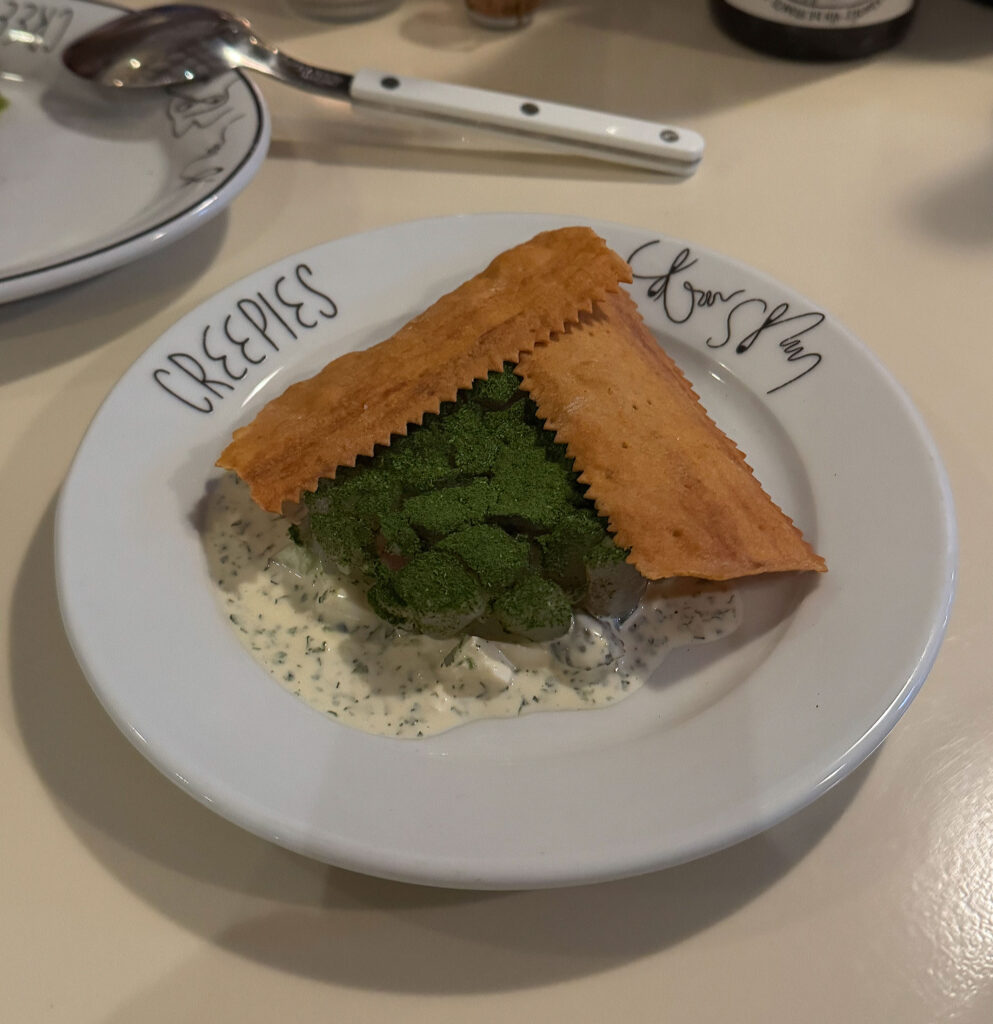
I have also found the “Fluke Tartare ‘Gribiche’” ($22) to be among the menu’s more challenging offerings. Still, with repeat exposure, I think I have been able to wrap my head around the recipe even if it does not necessarily appeal to my particular tastes.
The preparation continues to center on generous chunks of the titular fish that have been coated in an eggy, cornichon-studded dressing. However, the fluke is coated now more than ever in a fine green powder made from sauce gribiche’s signature herbs (like chervil, parsley, and tarragon). The sum effect looks more like an Elske dish than perhaps anything else offered here, and it displays a rather intriguing, anise-tinged sweetness that plays off of the more conventional richness and tang of the tartare. For my palate, it is only with the introduction of the accompanying crackers (so wonderfully buttery) that the plate really comes together. Correspondingly, I’d still really like to see one more of them provided. Yet, while this item still seems polarizing to me, I think it has reached an acceptable standard that a broader audience may find to be worth giving a try.
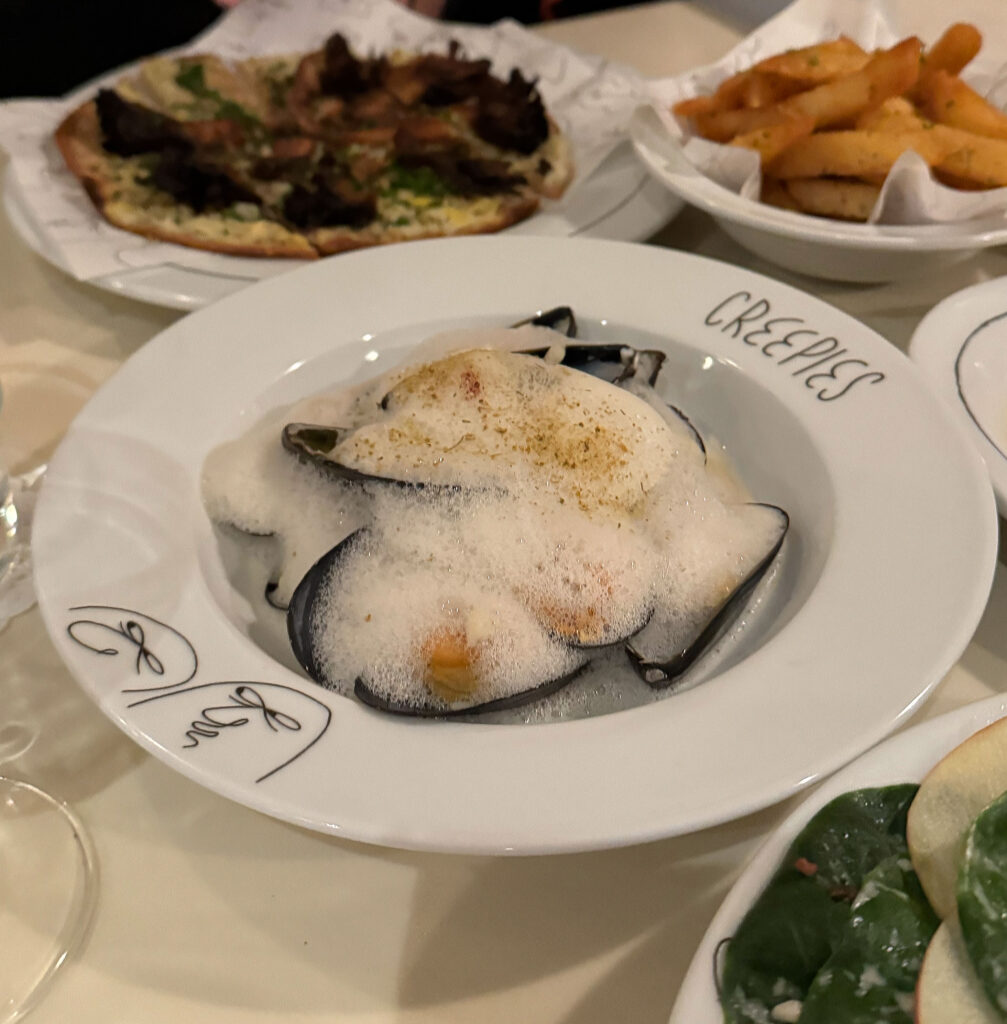
The “Steamed Mussels with Fennel Giardiniera & Pernod” ($24) stands among signatures like the gougères and saucisson. It’s execution—comprising sweet, plump pieces of the bivalve (tucked back into their shells) swimming in an anisey foam and punctuated by a touch of heat—has remained among the most consistent over time. I find both the textures and flavors to be rather elegantly rendered (almost prototypically for how Creepies looks to approach its genre) as well.
Tonight, nevertheless, it is worth mentioning that one of the mussels that lands in my mouth is sandy. This is not the end of the world (given the enjoyment offered by the remaining bites), but it should serve as a reminder of how demanding the work of cleaning seafood really is. If Creepies is going to be serving food that is so conceptionally challenging, it cannot afford to be making mechanical mistakes of this sort too.
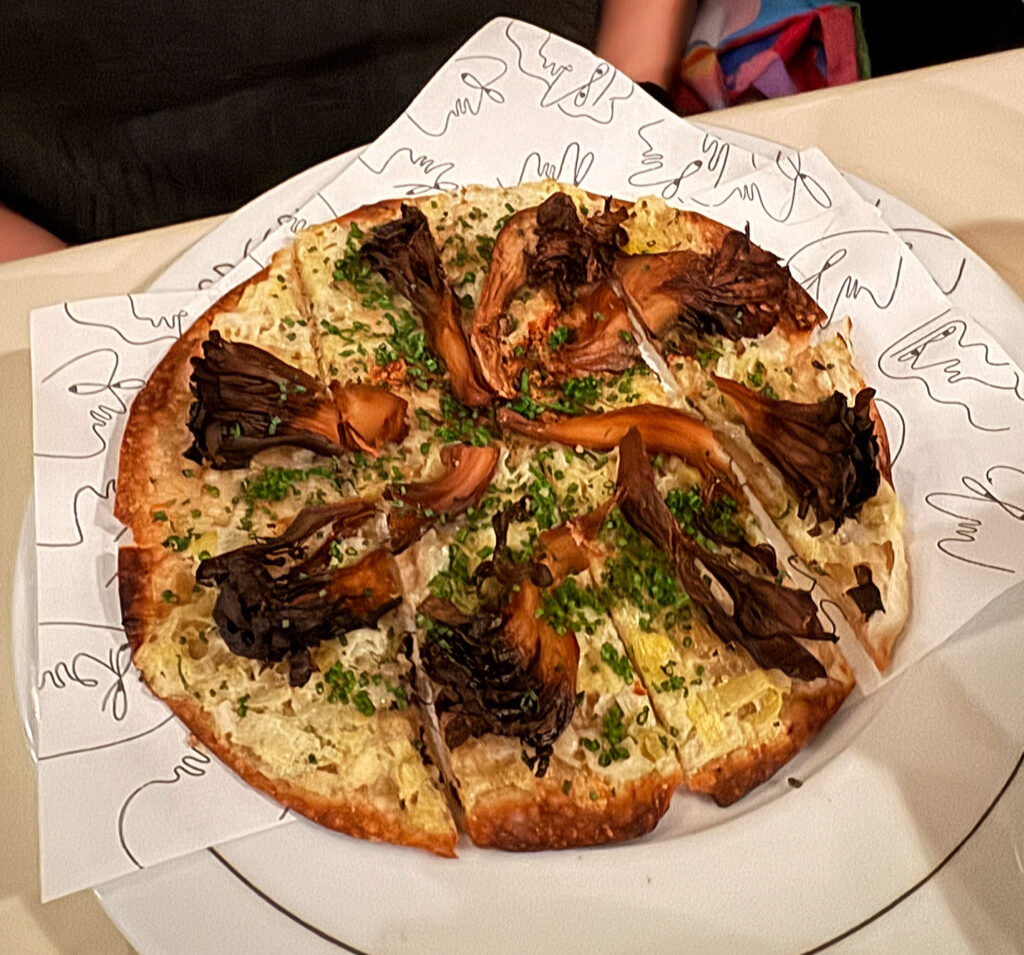
Thankfully, the “Tarte Flambé, Tavern Style” ($16) more or less fulfills its status as one of the restaurant’s most emblematic dishes. This play on the Alsatian flatbread (combining fromage blanc, onions, chives, and maitakes on a pizza-style crust) has not really changed from my last visit. It delivers a light, crisp base texture that transitions seamlessly to the creamier, sweet-and-savory toppings. The very tops of the mushrooms, by my measure, have been charred a little too much on this occasion. Yet their base remains pleasantly meaty, and the overall experience—charged with tang, earth, and allium—still makes for a reliable crowd-pleaser.
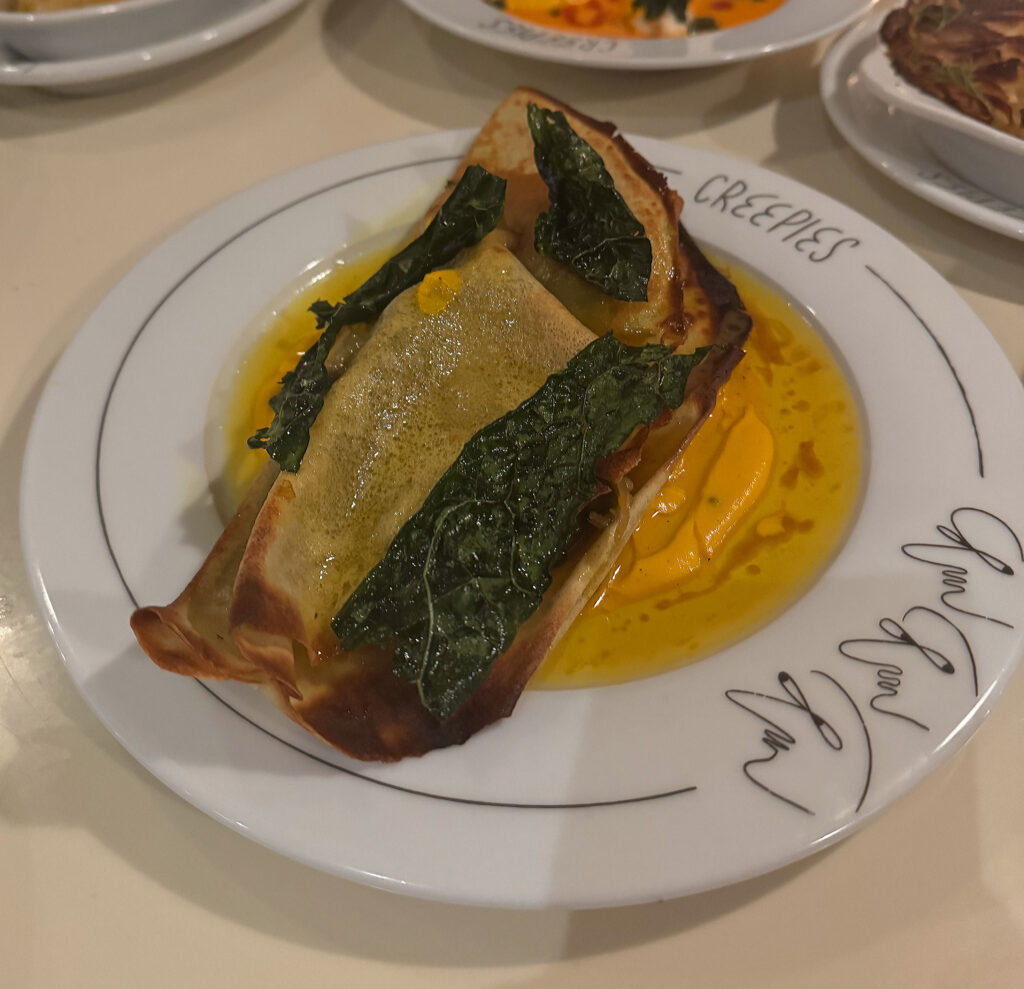
Arriving next, a ”Freekeh Crepe with Kuri Squash, Kale & Vadouvan” ($22) serves to replace the “Corn Crepe, Summer Succotash & Green Tomato” that I liked (not loved) last time. On the surface, I like the fact that this form is being used as the foundation for different seasonal combinations. Opting for freekeh (roasted green durum wheat) as a base, squash (a small, red, sweet variety) as a filling, and vadouvan (also called French curry) for flavoring strikes me as novel, yes, yet also autumnal.
Texturally, the crêpe displays beautiful browning (almost teetering toward blackness) around the edges and is folded in a manner that rigidly guards its interior. Matched by long leaves of crispy kale, the cooked batter yields a satisfying crackle. The filling, featuring tender chunks of the squash alongside some grains of the freekeh itself, is somewhat sparsely applied. However, I like the resulting sweetness provided opposite the smoky, nutty notes of the crêpe itself. The vadouvan should cap everything off with warm and creamy depth, yet I find the sauce makes the entire dish resoundingly wet. Indeed, once you start to cut into the crêpe, the whole thing seems to wilt. The result feels disjointed and messy, and, while I appreciate the kitchen’s thought process here, I am still not sure they have really mastered this form.

I was no great fan of the “Cod Meunière with Endive” ($23) either when I encountered it before. Elske treats that titular chicory so confidently and memorably (as part of a signature salad). Creepies just seems to throw them on top of some fried, flaky fish.
I can appreciate the juxtaposition of the raw endive leaves with their hidden, caramelized counterparts. However, I feel like the former need to be more aggressively dressed or otherwise softened a little in their own right. Their bitterness and crunch remain jarring, and I am left with the feeling that I would like this dish (centered on buttery cod, subtle crispness, and silky sweetness) much more if the raw endive was simply excised. (Hell, chop it up and turn it into some kind of tangy topping.) Admittedly, I may not be constructing complete bites in the proper fashion, but I just don’t see how the components are supposed to work.
The “Parisian Gnocchi with Swiss, Ham, & Egg Yolk” ($22) has undergone a minor bit of tweaking since I last tasted it. Namely, its Gruyère has been substituted for the titular holed cheese. My real problem with the preparation had to do with the stale cracker on top, the burnt chunks of pork below, and lack of salt that made it all seem heavy, bitter, and bland. Tonight, however, this play on a croque-madame comes closer to realizing its potential.
On the palate, the poached pâte à choux gnocchi feel rich and satisfying with the help of their creamy, eggy coating. This time, the cracker provides an expected, contrasting crunch while some smaller crispy bits and careful torching (applied underneath) further enhance the effect. The resulting flavor here—while still unabashedly rich—achieves greater balance thanks to adequate salt and porky depth that allow the sweeter, nuttier side of the Swiss to come to the fore. Overall, this now makes for one of the menu’s stronger items, but it’s also not one I’d say I’m absolutely blown away by.
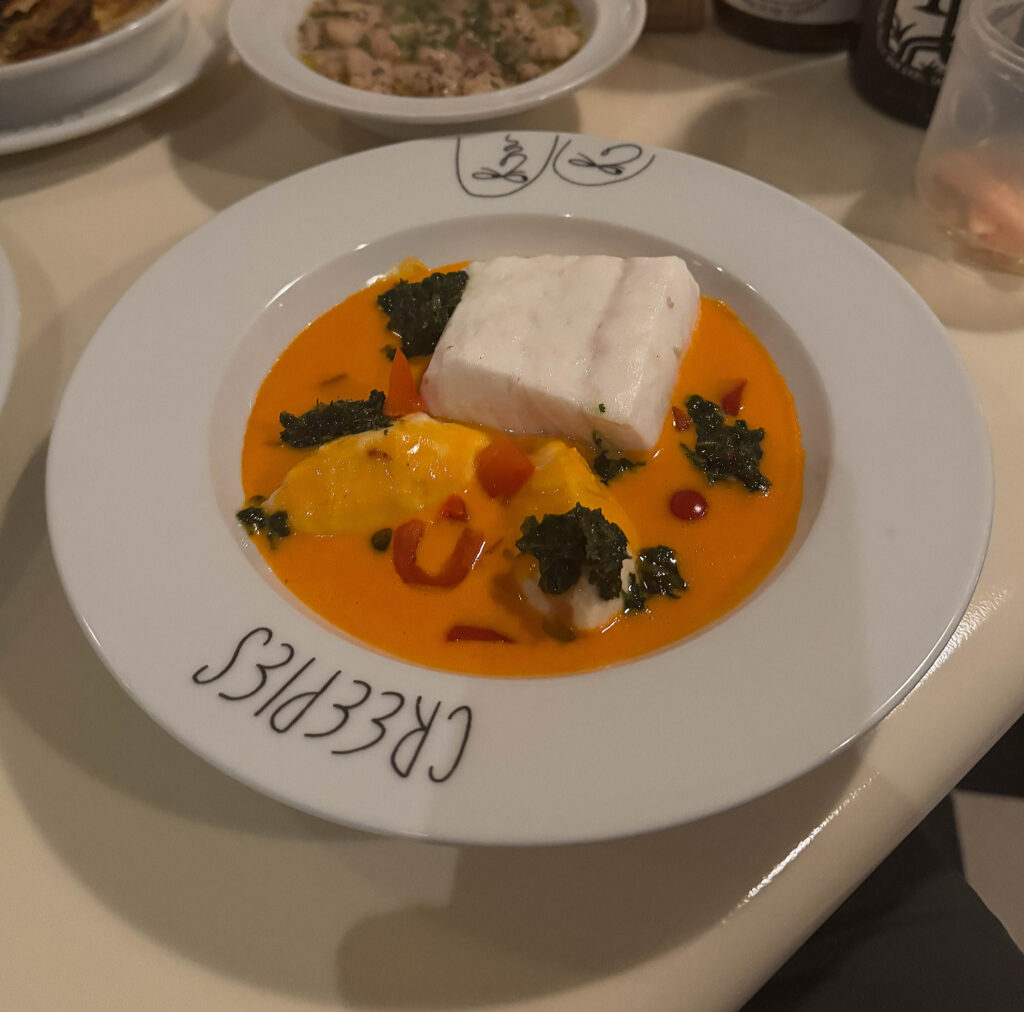
Turning toward the menu’s closing savory items, I encounter the “Halibut with Sauce Homard and Pickled Peppers” ($42). This is the only one of the restaurant’s three “entrées” that I have yet to sample, and it’s not really one I’d otherwise be compelled to order when meat is on offer. That said, I cannot deny that the resulting bowl (a milky white fillet swimming in deep orange sauce) looks stunning, and the accompanying quenelles (made from lobster meal) promise that there’s more going on here than just fish.
Texturally, the halibut feels firm and dense (appropriately so for anyone looking to make it their main). It’s probably on the border of being overcooked; however, I have little trouble getting the resulting flakes down with the added moisture of the sauce. Subsequently, I expect a rich, creamy, tomalley-charged sensation to strike, but any lobster flavor is totally overshadowed by high acid (one that is further amplified by the peppers). The quenelles, too, are stringy in their composition—so there’s little pleasure to be had there either. Ultimately, while the chosen elements could certainly work together, pretty much every part of this recipe needs to be improved. Choosing it over the chicken or lamb would positively derail someone’s experience.
When it comes to sides, the selection also remains a mixed bag.

“Savoy Cabbage with Whipped Sesame Cream” ($11) looks almost psychedelic in its composition, and it leads with a range of crunchy, charred textures that are enticingly moistened by the milky sauce. The resulting flavor here is sweet and nutty and maybe just a touch too bitter on the finish. I must also contend with one bite of cabbage (likely cut too close to the stem) that is so waxy that I must spit it out. Still, this is one of the better (and more longstanding) items in the category.
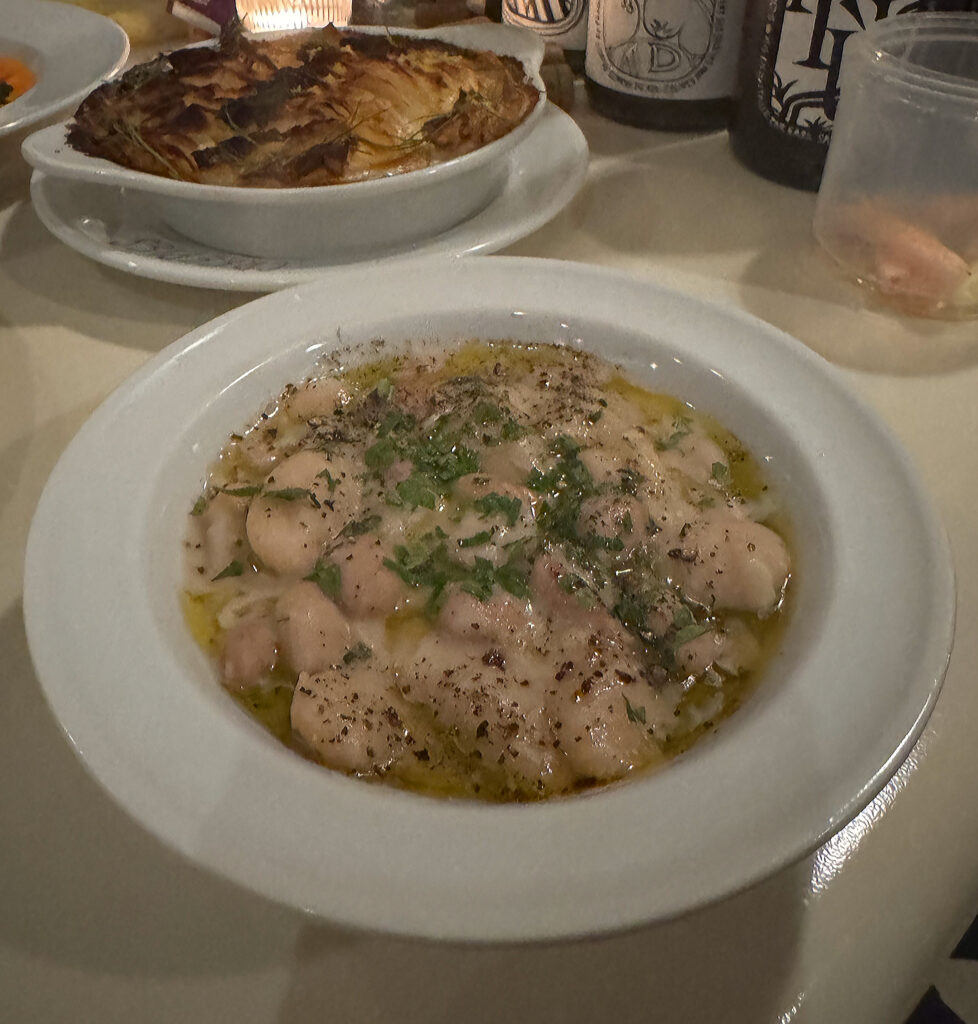
The ”Creamed Cranberry Beans with Fines Herbes” ($10) have replaced a similar preparation made with summer beans (that I vaguely remember trying but, obviously, found forgettable). The present version is impressively tender, a touch gooey, and balanced by enough salt and acid as to taste rather full and satisfying. In short, I would order it again.

The “Celeriac Dauphinois with Escargot” ($14) can be thought of as a reimagining of the “Pommes Ratatouille” that featured before. The resulting presentation—crispy waves of celery root filling the confines of a small skillet—certainly looks similar. However, the dish also suffers from the same flaw: a pervasive wetness and dilution that rob the recipe (despite a nice hint of richness from the snails) of any real savory power. I do think celeriac can successfully substitute for potato here, but the execution needs to be improved.
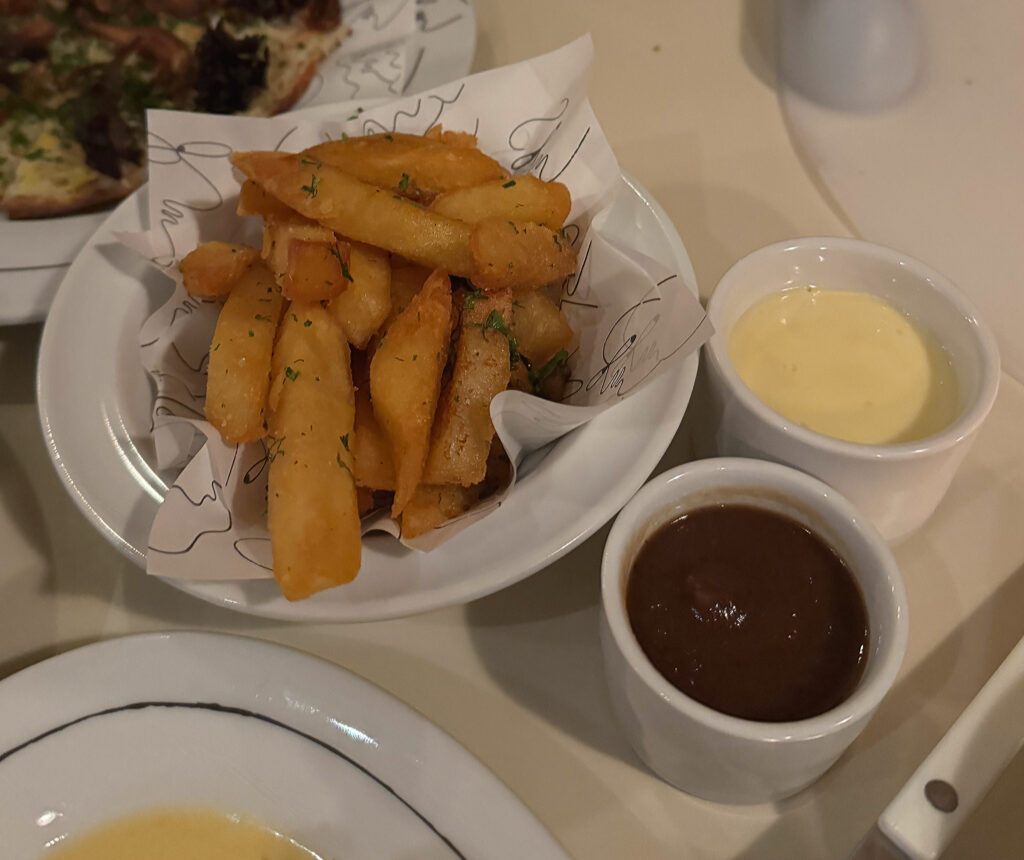
Finally, there’s the “French Fries” ($10): perhaps not the kind of dish that Creepies wants to be most known for, but one, in turn, that has remained ironclad in its quality. The combination of crunching shell, fluffy interior, those crisp herbs, and the supremely brittle fragments left at the bottom of the bowl is bewitching. The well-judged salting of the potatoes means one can enjoy them alone. However, ignoring the onion chutney would be a mistake. Once again, I must echo the praise that has placed these fries among the city’s very best examples of the form.
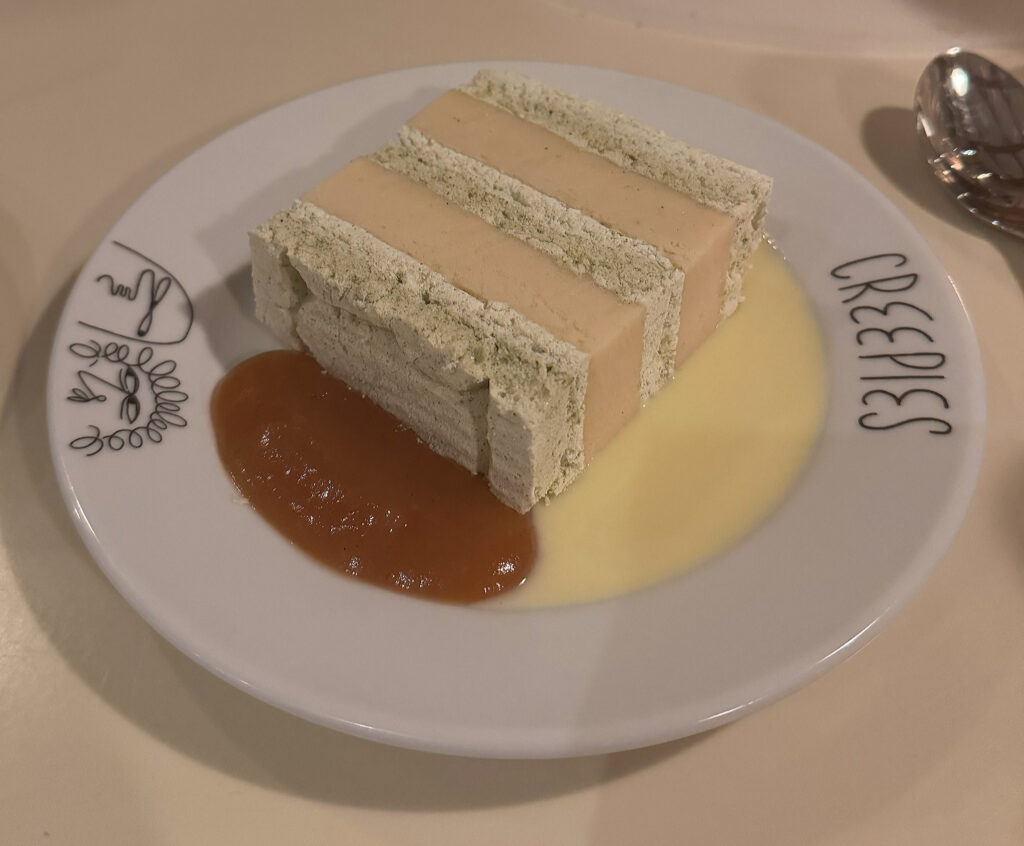
As far as dessert goes, I only have one new recipe to grapple with: a “Pear Sherbet + Herbed Meringue Cake with Buttermilk” ($14) that rather directly updates the “Raspberry Sherbet Meringue Cake” from last time. For me, the substitution in fruit makes for an upgrade too.
The pear, at core, tastes rounder and sweeter than its predecessor, and an accompanying compote made from the same ingredient displays a lovely depth of spice. The meringue element (which I even pluck out an enjoy on its own) remains expertly crisp and chewy. Further, its powdery, herbal coating adds a surprising savory edge to the assembled flavors. Thus, while the preparation continues to celebrate cooler, brighter notes (not always what I look for to close out a meal), it does so with enough surrounding complexity to feel satisfying. For me, this is the strongest of the sweets Creepies has yet served.
With that, my sixth visit to the restaurant reaches its conclusion: some 19 dishes (split into five distinct courses) served in a little more than 100 minutes (counting from the arrival of the bread to that of the lone dessert).
This is pretty superlative as far as pacing goes, signaling that, even if the restaurant hasn’t perfected every one of its recipes, the kitchen is more than capable of keeping tables on track. (Oh, how much worse faltering food is when you’re driven to the point of hunger while waiting for it to arrive.)
Otherwise, with the payment of the check (and its removable 4% service charge), I retrace my short path across the checkered floor, through the buzzy dining room, and back out the set of doors that now separate Creepies—strangely compelling (if at sometimes frustrating)—from a West Loop that largely seems alien by comparison.
In ranking the evening’s dishes:
I would place the “Warm Brie Gougères” and “French Fries” in the highest category: superlative recipes that stand among the best things I will be served in any restaurant this year.
Next come the “PQB Bread & Butter,” “Saucisson with Puff Pastry & Pistachio Mustard,” “Sunchoke Croquettes with Preserved Lemon,” “Roasted Carrots with Almonds, Sultanas & Fig Leaf,” “Fluke Tartare ‘Gribiche,’” “Steamed Mussels with Fennel Giardiniera & Pernod,” “Tarte Flambé, Tavern Style,” “Parisian Gnocchi with Swiss, Ham, & Egg Yolk,” “Creamed Cranberry Beans with Fines Herbes,” and “Pear Sherbet + Herbed Meringue Cake with Buttermilk”—very good—even great (though at times still imperfect)—preparations I would always be happy to sample again (but that just failed to elicit an extra degree of emotion). Of these, the “Sunchoke Croquettes,” “Roasted Carrots,” “Tarte Flambé, Tavern Style,” and “Pear Sherbet” came closest to reaching that higher level.
A step lower, one finds the “Crudités with Horseradish & Brown Butter,” “Cod Meunière with Endive,” and “Savoy Cabbage with Whipped Sesame Cream”—merely good (maybe just average) items that fell short when it came to texture or flavor. None of these bites faltered in more than one dimension, so there was still pleasure to be had (and, indeed, they could all easily be fixed with a little more tweaking).
Finally, we have the “Little Gem with Parsley Root, Apple & Sunflower Seeds,” “Freekeh Crepe with Kuri Squash, Kale & Vadouvan,” “Halibut with Sauce Homard and Pickled Peppers,” and “Celeriac Dauphinois with Escargot.” These dishes were clearly below average and often demonstrated flaws across multiple dimensions. While none of the plates were necessarily hard to finish, I am not compelled to order them again barring clear changes.
Overall, this makes for a hit-rate of 63%, a figure that still falls short of Creepies’s aspirations (not to mention Elske’s established quality) but one, in turn, that represents a clear improvement from the 52% I reported in September.
Yes, to frame this score more charitably, the restaurant’s cuisine is now at least 20% better than what I encountered last time. A few of the newer dishes have debuted immediately at that “would be happy to order again” level of quality, and some of the most notable signatures (like the “Saucisson” and “Parisian Gnocchi”) are now performing closer to where they should be.
A few of the weak links—like the “Crudités,” “Cod Meunière,” “Little Gem,” and “Celeriac Dauphinois” (insofar as it echoes the “Pommes Ratatouille”)—have also remained consistent, signaling that the kitchen may need to seriously interrogate some of its ideas or techniques. Yet, throughout any and all of the miscues tonight, I can never accuse the team of being lazy or uninspired in what they are aiming for.
Rather with the help of a homey setting, well-meaning (if still being sharpened) service, and two of Chicago’s best beverage pros behind it, the food at Creepies is moving in the right direction.
In the meantime, the weight of hype and expectations might make dining here a tricky proposition. Concepts touting this kind of popularity are asked to perform—immediately—even if those doing the cooking are only taking their first steps of experimentation and actualization. Though being busy is a blessing, it’s kind of a shame to contend with such a broad audience when some degree cult appeal (in the Elske mold) seems to be the intention.
Still, one can already have a great time at Creepies if they’re open to something more than conventional bistro food paired with conventional bistro drinks. For, when the dishes hit, they do so in a way that is without equal.
If and when that hit-rate gets closer to 80%, the Poseys and Ploshehanski will have built a place that truly invigorates and preserves what has almost become an endangered genre here. Add in all-day dining, and the city will have gained one of its surest, most singular concepts in years.


